...Best of Sicily presents... Best of Sicily Magazine. ... Dedicated to Sicilian art, culture, history, people, places and all things Sicilian. |
by L. Mendola and V. Salerno | |||||
Magazine Index Best of Sicily Arts & Culture Fashion Food & Wine History & Society About Us Travel Faqs Contact Map of Sicily
|
It has often been said that the Byzantines were Greek, but they were much more. Ethnically, the earliest Byzantines were, in fact, essentially Greek, with Roman, Balkan, Armenian, Slavic and western Asian strains. They called themselves "Romans" and spoke Greek, though Latin was also spoken in some quarters. Linguistically and culturally, their society was not very different from that of the Sicilians in the sixth century. As time went on, Byzantine society encompassed various eastern Mediterranean cultures to a large extent. Throughout most of its history, the Byzantine Empire was a monarchy --though not always a strictly hereditary or absolute one-- having legislative bodies and other democratic institutions considered exceptional in the Early Middle Ages. Over the centuries, Byzantine society and culture greatly influenced eastern Europe, and particularly the Kievan state which became Russia, as well as the cultures of the Caucasus to the east of the Black Sea, facilitating the introduction of Christianity in these regions. In AD 324, when Constantine I (the Great) became emperor of the Roman Empire, Byzantium was little more than a Greek town (founded before 500 BC) on the Bosporus strait. In 330, he made it the capital of the Empire, which was now essentially Christian. Byzantium was eventually renamed Constantinople and is now Istanbul in Turkey. Constantine sponsored the Council of Nicea (a town in Turkey) in 325. With participation of hundreds of bishops from across the Empire, it codified much of the theological and canonical substance of the early Christian Church still followed by Orthodox and Catholics today. Straddling Europe and Asia, Byzantium was destined to play a key role in early-medieval history. In 395, when the Empire was divided into east and west, this growing city became capital of the Eastern Roman Empire and resisted the raids of "Barbarians" (Germanic tribes and Huns) which destroyed the Empire in the West (Italy, Switzerland, France, Germany, Britain, Spain, Morocco, etc.), leaving Rome to fall to the Goths in 476. The Byzantine Empire was geographically its largest under Justinian I (ruled 527-565), who extended it to include Sicily and Peninsular Italy, seizing power from the Ostrogoths. Following a brief period of rule by the Vandals and Ostrogoths, Sicily, which --at least nominally-- was previously part of the Western Empire, was conquered (actually liberated) by the Byzantine general Belisarius in 535 as part of a Gothic-Byzantine war. Carthage, which was controlled by Vandals, had been conquered by the Byzantines a year earlier. Italian society immediately prior the Byzantine conquest had actually flourished under the Ostrogoth leaders Odoacer and Theodoric, who governed a quasi-Roman state there and in Sicily, but the Byzantines brought these regions under their administration and controlled parts of it well into the twelfth century. In addition to their defense of Christianity, the Byzantines preserved ancient Greek and Roman thought and traditions. Justinian's legal code (sometimes called the "Code of Justinian") is the basis for many legal systems still used today, but in his own time Justinian himself was viewed as an extremist whose defense of Christianity led to intolerance. This policy, though exceptional in the Byzantine Empire in successive years, resulted in the persecution of heretics, pagans and Jews. Byzantine art was a major influence in Sicily and elsewhere. Often, as in Christian iconography, it was more representational than realistic. Geometric motifs were common, and the use of mosaic was highly developed. Churches and palaces were usually built in the Romanesque style, sometimes with cupolas (domes). The crafts such as jewelry making and silk weaving flourished. Works of literature and history were widely appreciated. Not all Sicilians were Christians. Sicily had numerous Jewish communities,
even in certain small and remote towns. In Sicily, the Jews In Sicily, the few centuries of Byzantine rule were peaceful and prosperous, though taxation was high. The Byzantine cultural influence lasted well into the Arab and Norman eras. Under the Byzantines, as under the ancient Greeks and Romans, the Greek language was still widely spoken in Sicily. This was an evolving medieval Greek, not that of the ancients. Vulgar Latin was also spoken, though it was far less prevalent than Greek. Eventually, this Italic language, with Greek, Arabic and Norman French influences, became the medieval Romance language known as Sicilian. Linguistic evolution was a slow process, however, and Greek was still spoken throughout Sicily's Arab and Norman periods into the eleventh century. By 600, the Lombards (Longobard descendants in Lombardy in northern Italy)
were gradually occupying much of the Italian peninsula, though pockets of
Byzantine influence remained
--at least for a time-- in Venice, Ravenna and Bari, and a growing "Papal
State" increased its influence around Rome and beyond, owing much to
the efforts of Pope Gregory the Great, who believed in the Islam was growing, and Muslim Arab armies controlled Egypt, Syria and Palestine by 642. By 652, Muslim-Arab pirates based in Tunisia were undertaking isolated raids on the Sicilian coast. By 750, the Byzantine Empire, though influential, was greatly reduced in size, encompassing Asia Minor (Turkey), Greece, Sicily, and parts of the Balkans and peinsular Italy. Following a revolt against Constans, the capital was restored to Constantinople and Sicily found herself open to attack from abroad. In Islam's advance westward through Arab efforts, Carthage fell in 689. Muslim conquest often resulted in mass conversion of the conquered. In keeping with Koranic principles, the religious freedom of Jews and Christians was usually respected, but Muslims were accorded greater civil rights. Within two decades, several islands under Sicilian influence (such as Pantelleria) were occupied. Though the Sicilians traded with the Arabs (sometimes called "Saracens" or "Moors"), coastal raids became commonplace. These diminished somewhat after 750 owing to internal struggles among the Muslims. By 800, there were Arab merchants living in several Sicilian cities. In 805 and again in 813, the governor of Sicily signed trade treaties with the Aghlabids of Tunisia. Matters in Constantinople were not so serene. In 827, the Emperor ordered the arrest of Euphemius, governor of Sicily and a distinguished general. This prompted a revolt in which the general declared himself emperor. Faced with further dissension, Euphemius sought help from the Aghlabid emir, offering him Sicily (a profitable source of tax revenue) in return. The emir accepted, and soon a multi-ethnic force of at least ten thousand Persians, Berbers, Arabs and Spaniards occupied the western city of Mazara. Bal'harm (Palermo), formerly Panormus, was taken in 831 and soon became capital of one of the island's several emirates. Syracuse fell only in 878, and Taormina, the last Byzantine stronghold, in 902. Beginning in 867, the Emperor Basil and his descendants promoted a period of prosperity and scholarship in Constantinople. The Empire continued to exist as an important force in the Mediterranean, but only as a shadow of its former self. Some Italian cities remained under Byzantine control, at least nominally, but Sicily was lost. (Constantinople fell to the Turks in 1453, a date considered by many scholars to indicate the end of the Middle Ages.) Byzantine culture was not simply a question of Byzantine rule. In Sicily
and elsewhere, Byzantine society and culture melded with Arabic
culture. Indeed, Arabic and Islamic art and society were greatly influenced
by Byzantium. Mosques were constructed, often with the help of Byzantine
craftsmen, and in Sicily the Church, formally under the Patriarchate of
Constantinople from 732, remained solidly Orthodox into The Schism between the Patriarch of Rome and the patriarchs of the East occurred in 1054, when Sicily was ruled by Muslim emirs. Long before this date zealous Patriarchs of Rome (the Popes) were already encouraging Norman knights in southern Italy to conquer Sicily, thus bringing it into a sphere of influence which was not only Christian but specifically Latin. The reasons for the Schism were political as well as theological. In the wake of this bitter separation, the "Catholic" Church of Rome was to grow further away from the "Orthodox" Church of Constantinople and the entire East. Catholic theology, doctrine and liturgy became increasingly altered. The Normans conquered Messina in 1061 and took Palermo a decade later. In Sicily, the introduction of Latin clergy, and the use of the Latin language in liturgy, were gradually introduced in the years following. By the time Frederick II ascended the throne as a young man early in the thirteenth century, little remained of Orthodoxy in Sicily except a few icons. The new Latinization attenuated the importance of Byzantine culture generally --even linguistically. In Frederick's Palermo, Greek and Arabic were still spoken. This soon changed, however. Generation by generation, the Greek language was cast aside, and Sicilian emerged as a solidly Latin (Romance) tongue, albeit with Arabic and Greek influences. (This Latinization of the Sicilian vernacular was not unlike the Normans' Latinization of English during the same period.) Yet, in the context of a society made up of several cultures, Byzantine art flourished in Sicily well into the twelfth century. Bearing the marks of Orthodoxy, the Normans' earliest Roman Catholic churches, featuring mosaic icons and other Byzantine elements, look more Eastern than Western. (The Martorana of Palermo, and the cathedrals of Monreale and Cefalù come to mind, but also numerous smaller churches and monasteries, particularly in "Byzantine" northeastern Sicily.) Byzantine rule did not result in a mass "colonization" of Sicily like those of the ancient Greeks or medieval Arabs, but there was certainly immigration and trade. Constantinople's lasting effects in Sicily far transcended her waning political influence. About the Authors: Luigi Mendola is the History Editor of Best of Sicily and author of several books. Palermo native Vincenzo Salerno, who contributed to this article, has written biographies of several famous Sicilians, including Frederick II and Giuseppe di Lampedusa. | ||||
Top of Page |
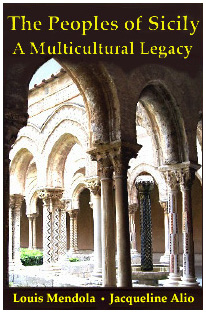
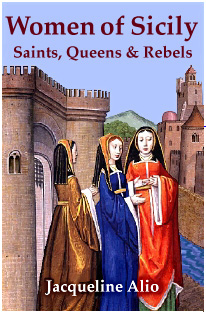
 Born of the society of the Eastern Roman Empire, the Byzantine
Empire lasted throughout the Middle Ages - its traditions and culture at
once
Born of the society of the Eastern Roman Empire, the Byzantine
Empire lasted throughout the Middle Ages - its traditions and culture at
once 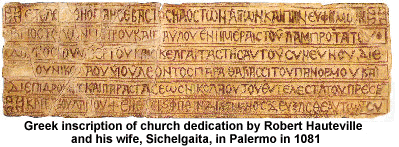 dominated certain
fields, particularly some of the textile trades. Though (largely by choice)
they lived in certain districts, the Jews were not very different, socially
speaking, from the Orthodox Christians of Sicily. The serious persecution
of Sicilian Jews was essentially a late medieval development in Sicily,
encouraged from Papal and Spanish circles. As their urbanized population
was small and productive, they attracted little negative attention from
the Byzantines, Arabs and Normans.
dominated certain
fields, particularly some of the textile trades. Though (largely by choice)
they lived in certain districts, the Jews were not very different, socially
speaking, from the Orthodox Christians of Sicily. The serious persecution
of Sicilian Jews was essentially a late medieval development in Sicily,
encouraged from Papal and Spanish circles. As their urbanized population
was small and productive, they attracted little negative attention from
the Byzantines, Arabs and Normans.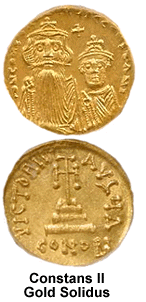 independence
of the Papacy from the collegial traditions espoused by the other patriarchs.
Developments in Italy did not immediately affect Sicily, where the Emperor
Constans decided to establish his capital in 660. Syracuse, still the island's
most important city, became his residence until his untimely assassination
in 668. The Emperor's tryannical demeanor and costly maintenance did not
endear him to the Sicilians.
independence
of the Papacy from the collegial traditions espoused by the other patriarchs.
Developments in Italy did not immediately affect Sicily, where the Emperor
Constans decided to establish his capital in 660. Syracuse, still the island's
most important city, became his residence until his untimely assassination
in 668. The Emperor's tryannical demeanor and costly maintenance did not
endear him to the Sicilians.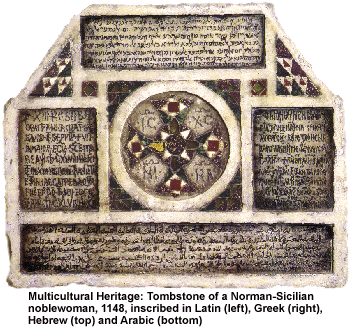 the early years
of Norman rule, when the beginnings of Latinization took place.
the early years
of Norman rule, when the beginnings of Latinization took place.